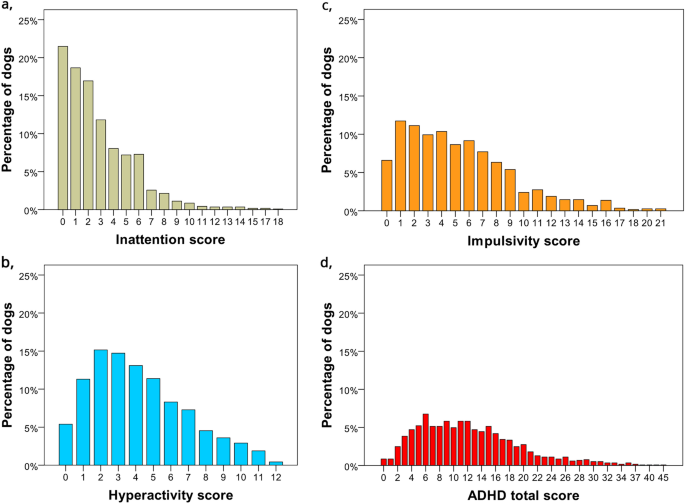Development of a human-analogue, 3-symptom domain Dog ADHD and Functionality Rating Scale (DAFRS)
書誌情報Csibra, B., Bunford, N. & Gácsi, M. Development of a human-analogue, 3-symptom domain Dog ADHD and Functionality Rating Scale (DAFRS). Sci Rep 14, 1808 (2024). https://doi.org/10.1038/s41598-024-51924-9
表題の論文を日本語訳してみました。翻訳アプリにかけた日本語訳を英文に照らして修正していますが、表記のゆれや訳の間違いがあるかもしれません。正確に内容を知りたい方は、原文をご覧ください。
Abstract:要旨
The family dog, in its natural environment, exhibits neuropsychological deficits redolent of human psychiatric disorders, including behaviours that are similar to human attention-deficit/hyperactivity disorder (ADHD) symptoms.
家庭犬は自然環境において、人間の注意欠陥・多動性障害(ADHD)の症状に似た行動を含む、人間の精神疾患を思わせる神経心理学的障害を示す。
Based on standard questionnaire methods in humans, we aimed to develop and validate a detailed, psychometrically improved tool to assess owner views on relevant dog behaviours. We modified available questionnaires by adding items that allow for separate analysis of impulsivity, and items on functional impairment.
ヒトにおける標準的な質問紙法に基づき、犬の関連行動に関する飼い主の見解を評価するための、詳細で心理測定学的に改良されたツールを開発し、検証することを目的とした。入手可能な質問票を改良し、衝動性を個別に分析できる項目と機能障害に関する項目を追加した。
We collected data from 1168 owners for different validation steps of the new questionnaire and, similarly to assessment of humans where teachers also evaluate as an expert control, we collected data from dog trainers.
私たちは、新しい質問票のさまざまな検証ステップのために1168人の飼い主からデータを収集し、また、教師も専門家として評価するヒトの評価手法同様、ドッグトレーナーからもデータを収集した。
Exploratory and confirmatory factor analysis revealed 3 factors: inattention (IA), hyperactivity (H) and impulsivity (I), corresponding to all three human symptom dimensions in dogs. Test–retest analyses showed excellent agreement between measurements for all factors.
探索的因子分析と確証的因子分析により、不注意(IA)、多動性(H)、衝動性(I)の3因子が明らかになった。テスト・リテスト分析では、すべての因子について測定間の優れた一致が示された。
Similarly to findings with humans, trainer-owner rating comparisons showed fair (IA) to moderate (H, I) agreement. As in humans, greater ADHD scores were associated with greater functional impairment scores.
ヒトでの所見と同様に、トレーナーと飼い主の評価比較では、まずまず(IA)から中程度(H、I)の一致が見られた。ヒトと同様、ADHDのスコアが高いほど機能障害のスコアも高かった。
We suggest that in dogs, similarly to humans, parallel examination of (extreme) ADHD and functional impairment scores could help distinguish diagnosable individuals, after further validation of the questionnaire using a relevant behaviour test.
犬においても、ヒトと同様に、(極端な)ADHDと機能障害のスコアを並行して調べることで、診断可能な個体の区別に役立つ可能性がある。
References:参考文献
- Matte, B. et al. ADHD in DSM-5: A field trial in a large, representative sample of 18- to 19-year-old adults. Psychol. Med. 45, 361–373 (2015).
– Article CAS PubMed Google Scholar - Fayyad, J. et al. Cross-national prevalence and correlates of adult attention-deficit hyperactivity disorder. Br. J. Psychiatry 190, 402–409 (2007).
– Article CAS PubMed Google Scholar - American Psychiatric Association. Diagnostic and Statistical Manual of Mental Disorders, Fifth Edition, Text Revision (DSM-5-TRTM) (American Psychiatric Association, 2022).
– Book Google Scholar Barkley, R. A. & Murphy, K. R. Impairment in occupational functioning and adult ADHD: The predictive utility of executive function (EF) ratings versus EF tests. Arch. Clin. Neuropsychol. 25, 157–173 (2010).
– Article PubMed PubMed Central Google Scholar- Bunford, N., Evans, S. W. & Wymbs, F. ADHD and emotion dysregulation among children and adolescents. Clin. Child. Fam. Psychol. Rev. 18, 185–217 (2015).
– Article PubMed Google Scholar - de la Peña, I. C., Pan, M. C., Thai, C. G. & Alisso, T. Attention-deficit/hyperactivity disorder predominantly inattentive subtype/presentation: Research progress and translational studies. Brain Sci. 10, 292 (2020).
– Article PubMed PubMed Central Google Scholar - Freedman, J. E. & Honkasilta, J. M. Dictating the boundaries of ab/normality: A critical discourse analysis of the diagnostic criteria for attention deficit hyperactivity disorder and hyperkinetic disorder. Disabil. Soc. 32, 565–588 (2017).
– Article Google Scholar - Bakhshani, N.-M. Impulsivity: A predisposition toward risky behaviors. Int. J. High Risk Behav. Addict. 3, e20428 (2014).
– Article PubMed PubMed Central Google Scholar - Dalley, J. W., Everitt, B. J. & Robbins, T. W. Impulsivity, compulsivity, and top-down cognitive control. Neuron 69, 680–694 (2011).
– Article CAS PubMed Google Scholar - Pelham, W., Fabiano, G. & Massetti, G. Evidence-based assessment of attention deficit hyperactivity disorder in children and adolescents. J. Clin. Child Adolesc. Psychol. 53(34), 449–476 (2005).
– Article Google Scholar - Cantwell, D. P., Lewinsohn, P. M., Rohde, P. & Seeley, J. R. Correspondence between adolescent report and parent report of psychiatric diagnostic data. J. Am. Acad. Child Adolesc. Psychiatry 36, 610–619 (1997).
– Article CAS PubMed Google Scholar - Evans, S. W., Owens, J. & Bunford, M. N. Evidence-based psychosocial treatments for children and adolescents with attention-deficit/hyperactivity disorder. J. Clin. Child Adolesc. Psychol. 43, 527–551 (2014).
– Article PubMed Google Scholar - American Psychiatric Association. Diagnostic and Statistical Manual of Mental Disorders: DSM-5 (American Psychiatric Association, 2013).
– Book Google Scholar - DuPaul, G. J., Power, T. J., Anastopoulos, A. D. & Reid, R. ADHD Rating Scale 5 for Children and Adolescents: Checklists, Norms, and Clinical Interpretation (Guilford Publications, 2016).
– Google Scholar - Evans, S. W. et al. Measuring ADHD and ODD symptoms and impairment using high school teachers’ ratings. J. Clin. Child Adolesc. Psychol. 42, 197–207 (2013).
– Article PubMed Google Scholar - Biederman, J., Mick, E. & Faraone, S. V. Age-dependent decline of symptoms of attention deficit hyperactivity disorder: Impact of remission definition and symptom type. AJP 157, 816–818 (2000).
– Article CAS Google Scholar - Barkley, R. A., Murphy, K. R. & Fischer, M. ADHD in Adults: What the Science Says (Guilford Press, 2010).
– Google Scholar - Caterino, L. C., Gómez-Benito, J., Balluerka, N., Amador-Campos, J. A. & Stock, W. A. Development and validation of a scale to assess the symptoms of attention-deficit/hyperactivity disorder in young adults. Psychol. Assess. 21, 152–161 (2009).
– Article PubMed Google Scholar - Glutting, J. J., Youngstrom, E. A. & Watkins, M. W. ADHD and college students: Exploratory and confirmatory factor structures with student and parent data. Psychol. Assess. 17, 44–55 (2005).
– Article PubMed Google Scholar - Span, S. A., Earleywine, M. & Strybel, T. Z. Confirming the factor structure of attention deficit hyperactivity disorder symptoms in adult, nonclinical samples. J. Psychopathol. Behav. Assess. 24, 129–136 (2002).
– Article Google Scholar - Russell, V. A. Overview of animal models of attention deficit hyperactivity disorder (ADHD). Curr. Protoc. Neurosci. 54, 9–35 (2011).
– Google Scholar - Topál, J., Román, V. & Turcsán, B. The dog (Canis familiaris) as a translational model of autism: It is high time we move from promise to reality. WIREs Cogn. Sci. 10, e1495 (2019).
– Article Google Scholar - Cummings, B. J., Su, J. H., Cotman, C. W., White, R. & Russell, M. J. β-Amyloid accumulation in aged canine brain: A model of early plaque formation in Alzheimer’s disease. Neurobiol. Aging 14, 547–560 (1993).
– Article CAS PubMed Google Scholar - Bleuer-Elsner, S. et al. Computational analysis of movement patterns of dogs with ADHD-like behavior. Animals 9, 1140 (2019).
– Article PubMed PubMed Central Google Scholar - Bunford, N. et al. Associations among behavioral inhibition and owner-rated attention, hyperactivity/impulsivity, and personality in the domestic dog (Canis familiaris). J. Comp. Psychol. 133, 233–243 (2019).
– Article PubMed Google Scholar - Bunford, N., Csibra, B. & Gácsi, M. Individual differences in response to ambiguous stimuli in a modified Go/No-Go paradigm are associated with personality in family dogs. Sci. Rep. 9, 11067 (2019).
– Article ADS PubMed PubMed Central Google Scholar - Csibra, B., Bunford, N. & Gácsi, M. Evaluating ADHD assessment for dogs: A replication study. Animals 12, 807 (2022).
– Article PubMed PubMed Central Google Scholar - Fux, A. et al. Objective video-based assessment of ADHD-like canine behavior using machine learning. Animals 11, 2806 (2021).
– Article PubMed PubMed Central Google Scholar - Hoppe, N., Bininda-Emonds, O. R. P. & Gansloßer, U. Correlates of attention deficit hyperactivity disorder (ADHD)-like behavior in domestic dogs: First results from a questionnaire-based study. Vet. Med. Open J. 2, 95–131 (2017).
Article Google Scholar - Sulkama, S. et al. Canine hyperactivity, impulsivity, and inattention share similar demographic risk factors and behavioural comorbidities with human ADHD. Transl. Psychiatry 11, 1–9 (2021).
Article Google Scholar - Vas, J., Topál, J., Péch, É. & Miklósi, Á. Measuring attention deficit and activity in dogs: A new application and validation of a human ADHD questionnaire. Appl. Anim. Behav. Sci. 103, 105–117 (2007).
Article Google Scholar - Wright, H. F., Mills, D. S. & Pollux, P. M. J. Development and validation of a psychometric tool forassessing impulsivity in the domestic dog (Canis familiaris). Int. J. Comp. Psychol. 24, 210–225 (2011).
Article Google Scholar - Hejjas, K. et al. Novel repeat polymorphisms of the dopaminergic neurotransmitter genes among dogs and wolves. Mamm. Genome 18, 871–879 (2007).
Article PubMed Google Scholar - Kubinyi, E. et al. Polymorphism in the tyrosine hydroxylase (TH) gene is associated with activity-impulsivity in German Shepherd Dogs. PLOS ONE 7, e30271 (2012).
Article ADS CAS PubMed PubMed Central Google Scholar - Wan, M. et al. DRD4 and TH gene polymorphisms are associated with activity, impulsivity and inattention in Siberian Husky dogs. Anim. Genet. 44, 717–727 (2013).
Article CAS PubMed Google Scholar - Lit, L. et al. Characterization of a dopamine transporter polymorphism and behavior in Belgian Malinois. BMC Genet. 14, 45 (2013).
Article CAS PubMed PubMed Central Google Scholar - Lit, L., Belanger, J. M., Boehm, D., Lybarger, N. & Oberbauer, A. M. Differences in behavior and activity associated with a poly (a) expansion in the dopamine transporter in Belgian Malinois. PLoS ONE 8, e82948 (2013).
Article ADS PubMed PubMed Central Google Scholar - Gerencsér, L., Bunford, N., Moesta, A. & Miklósi, Á. Development and validation of the Canine Reward Responsiveness Scale –Examining individual differences in reward responsiveness of the domestic dog. Sci. Rep. 8, 4421 (2018).
Article ADS PubMed PubMed Central Google Scholar - Puurunen, J. et al. A non-targeted metabolite profiling pilot study suggests that tryptophan and lipid metabolisms are linked with ADHD-like behaviours in dogs. Behav. Brain. Funct. 12, 27 (2016).
Article PubMed PubMed Central Google Scholar - Sagvolden, T., Russell, V. A., Aase, H., Johansen, E. B. & Farshbaf, M. Rodent models of attention-deficit/hyperactivity disorder. Biol. Psychiatry 57, 1239–1247 (2005).
Article PubMed Google Scholar - Bleuer-Elsner, S., Muller, G., Beata, C., Zamansky, A. & Marlois, N. Effect of fluoxetine at a dosage of 2–4 mg/kg daily in dogs exhibiting hypersensitivity-hyperactivity syndrome, a retrospective study. J. Vet. Behav. 44, 25–31 (2021).
Article Google Scholar - González-Martínez, Á., Muñiz de Miguel, S., Graña, N., Costas, X. & Diéguez, F. J. Serotonin and dopamine blood levels in ADHD-like dogs. Animals 13, 1037 (2023).
Article PubMed PubMed Central Google Scholar - Barkley, R. A. & Fischer, M. The unique contribution of emotional impulsiveness to impairment in major life activities in hyperactive children as adults. J. Am. Acad. Child Adolesc. Psychiatry 49, 503–513 (2010).
PubMed Google Scholar - Gibbins, C., Toplak, M. E., Flora, D. B., Weiss, M. D. & Tannock, R. Evidence for a general factor model of ADHD in adults. J. Atten. Disord. 16, 635–644 (2012).
Article PubMed Google Scholar - Glutting, J. J., Monaghan, M. C., Adams, W. & Sheslow, D. Some psychometric properties of a system to measure ADHD among college students: Factor pattern, reliability, and one-year predictive validity. Meas. Eval. Couns. Dev. 34, 194–209 (2002).
Article Google Scholar - Gomez, R., Stavropoulos, V., Zarate, D. & Griffiths, M. ADHD symptoms, the current symptom scale, and exploratory structural equation modeling: A psychometric study. Res. Dev. Disabil. 111, 103850 (2021).
- Kofler, M. J. et al. Rethinking hyperactivity in pediatric ADHD: Preliminary evidence for a re-conceptualization of hyperactivity/impulsivity from the perspective of informant perceptual processes. Psychol. Assess. 32, 752–767 (2020).
Article PubMed PubMed Central Google Scholar - Toplak, M. E. et al. The unity and diversity of inattention and hyperactivity/impulsivity in ADHD: Evidence for a general factor with separable dimensions. J. Abnorm. Child Psychol. 37, 1137–1150 (2009).
Article PubMed Google Scholar - De Los Reyes, A. et al. The validity of the multi-informant approach to assessing child and adolescent mental health. Psychol. Bull. 141, 858–900 (2015).
Article PubMed Central Google Scholar - De Los Reyes, A. & Kazdin, A. Informant discrepancies in the assessment of childhood psychopathology: A critical review, theoretical framework, and recommendations for further study. Psychol. Bull. 131, 483–509 (2005).
Article Google Scholar - Narad, M. et al. Parent- teacher agreement on ADHD symptoms across development. Psychol. Assess. 27, 239–248 (2015).
Article PubMed Google Scholar - Dinwoodie, I. R., Dwyer, B., Zottola, V., Gleason, D. & Dodman, N. H. Demographics and comorbidity of behavior problems in dogs. J. Vet. Behav. 32, 62–71 (2019).
Article Google Scholar - Salonen, M. et al. Prevalence, comorbidity, and breed differences in canine anxiety in 13,700 Finnish pet dogs. Sci. Rep. 10, 2962 (2020).
Article ADS CAS PubMed PubMed Central Google Scholar - Velicer, W. F. & Fava, J. L. Affects of variable and subject sampling on factor pattern recovery. Psychol. Methods 3, 231–251 (1998).
Article Google Scholar - Lit, L., Schweitzer, J. B., Iosif, A.-M. & Oberbauer, A. M. Owner reports of attention, activity, and impulsivity in dogs: A replication study. Behav. Brain Funct. 6, 1 (2010).
Article PubMed PubMed Central Google Scholar - Weijters, B. & Baumgartner, H. Misresponse to reversed and negated items in surveys: A review. J. Market. Res. 49, 737–747 (2012).
Article Google Scholar - Weckerly, J. et al. Attention on inattention: The differential effect of caregiver education on endorsement of ADHD symptoms. J. Dev. Behav. Pediatr. 26, 201–208 (2005).
Article PubMed PubMed Central Google Scholar - Hardy, K. K. et al. Factor structure of parent- and teacher-rated attention-deficit/hyperactivity disorder symptoms in the Preschoolers with Attention-Deficit/Hyperactivity Disorder Treatment Study (PATS). J. Child Adolesc. Psychopharmacol. 17, 621–633 (2007).
Article PubMed Google Scholar - Martel, M. M., Levinson, C. A., Langer, J. K. & Nigg, J. T. A network analysis of developmental change in ADHD symptom structure from preschool to adulthood. Clin. Psychol. Sci. 4, 988–1001 (2016).
Article PubMed PubMed Central Google Scholar - Winstanley, C. A., Eagle, D. M. & Robbins, T. W. Behavioral models of impulsivity in relation to ADHD: Translation between clinical and preclinical studies. Clin. Psychol. Rev. 26, 379–395 (2006).
Article PubMed PubMed Central Google Scholar - Riemer, S., Mills, D. S. & Wright, H. Impulsive for life? The nature of long-term impulsivity in domestic dogs. Anim. Cogn. 17, 815–819 (2014).
Article PubMed Google Scholar - Wright, H. F., Mills, D. S. & Pollux, P. M. J. Behavioural and physiological correlates of impulsivity in the domestic dog (Canis familiaris). Physiol. Behav. 105, 676–682 (2012).
Article CAS PubMed Google Scholar - Brucks, D., Soliani, M., Range, F. & Marshall-Pescini, S. Reward type and behavioural patterns predict dogs’ success in a delay of gratification paradigm. Sci. Rep. 7, 42459 (2017).
Article ADS PubMed PubMed Central Google Scholar - Nigg, J. T. Attention and impulsivity. In Developmental Psychopathology 1–56 (John Wiley & Sons Ltd, 2016).
Google Scholar - Gullo, M. J., Loxton, N. J. & Dawe, S. Impulsivity: Four ways five factors are not basic to addiction. Addict. Behav. 39, 1547–1556 (2014).
Article PubMed Google Scholar - Hoeffding, L. K. et al. Symptoms of ADHD are highly common in undiagnosed adults—A cross-sectional study in a large population of Danes (2018).
https://meddocsonline.org/journal-of-psychiatry-and-behavioral-sciences/Symptoms-of-ADHD-are-highly-common-in-undiagnosed-adults-A-cross-sectional-study-in-a-large-population-of-Danes.html - Polderman, T. J. C. et al. Across the continuum of attention skills: A twin study of the SWAN ADHD rating scale. J. Child Psychol. Psychiatry 48, 1080–1087 (2007).
Article PubMed Google Scholar - Spinella, M. Normative data and a short form of the Barratt Impulsiveness Scale. Int. J. Neurosci. 117, 359–368 (2007).
Article PubMed Google Scholar - Swanson, J. M. et al. Categorical and dimensional definitions and evaluations of symptoms of ADHD: History of the SNAP and the SWAN rating scales. Int. J. Educ. Psychol. Assess. 10, 51–70 (2012).
PubMed PubMed Central Google Scholar - Murray, A. L., Booth, T., Ribeaud, D. & Eisner, M. Disagreeing about development: An analysis of parent-teacher agreement in ADHD symptom trajectories across the elementary school years. Int. J. Methods Psychiatr. Res. 27, e1723 (2018).
Article PubMed PubMed Central Google Scholar - Hartman, C. A., Rhee, S. H., Willcutt, E. G. & Pennington, B. F. Modeling rater disagreement for ADHD: Are parents or teachers biased?. J. Abnorm. Child Psychol. 35, 536–542 (2007).
Article PubMed Google Scholar - Skogli, E. W., Teicher, M. H., Andersen, P. N., Hovik, K. T. & Øie, M. ADHD in girls and boys—gender differences in co-existing symptoms and executive function measures. BMC Psychiatry 13, 298 (2013).
Article PubMed PubMed Central Google Scholar - Scandurra, A., Alterisio, A., Di Cosmo, A. & D’Aniello, B. Behavioral and perceptual differences between sexes in dogs: An overview. Animals 8, 151 (2018).
Article PubMed PubMed Central Google Scholar - Martínez, Á. G. et al. Risk factors associated with behavioral problems in dogs. J. Vet. Behav. 6, 225–231 (2011).
Article Google Scholar - Takeuchi, Y., Ogata, N., Houpt, K. A. & Scarlett, J. M. Differences in background and outcome of three behavior problems of dogs. Appl. Anim. Behav. Sci. 70, 297–308 (2001).
Article CAS PubMed Google Scholar - Fadel, F. R. et al. Differences in trait impulsivity indicate diversification of dog breeds into working and show lines. Sci. Rep. 6, 22162 (2016).
Article ADS CAS PubMed PubMed Central Google Scholar - Chung, T., Park, C., Kwon, Y. & Yeon, S. Prevalence of canine behavior problems related to dog-human relationship in South Korea—A pilot study. J. Vet. Behav. 11, 26–30 (2016).
Article Google Scholar - Maarschalkerweerd, R. J., Endenburg, N., Kirpensteijn, J. & Knol, B. W. Influence of orchiectomy on canine behaviour. Vet. Rec. 140, 617–619 (1997).
Article CAS PubMed Google Scholar - Tatai, K., Fodor, K. & Vetter, S. Conditions and practice of pet adoption of animal welfare NGOs in Hungary—A magyarországi állatvédő szervezetek örökbeadási feltételei és gyakorlata. Magy. Allatorv. Lapja 2022, 543–554 (2022).
Google Scholar - Villa, P. et al. Behavioural and physiological responses of shelter dogs to long-term confinement. Vet. Ital. 49, 231–241 (2013).
PubMed Google Scholar - Jensen, J. B. H., Sandøe, P. & Nielsen, S. S. Owner-related reasons matter more than behavioural problems—a study of why owners relinquished dogs and cats to a Danish animal shelter from 1996 to 2017. Animals 10, 1064 (2020).
Article PubMed PubMed Central Google Scholar - Salman, M. D. et al. Behavioral reasons for relinquishment of dogs and cats to 12 shelters. J. Appl. Anim. Welf. Sci. 3, 93–106 (2000).
Article Google Scholar - Xie, Y. et al. Effectiveness of physical activity intervention on ADHD symptoms: A systematic review and meta-analysis. Front. Psychiatry 12, 706625 (2021).
Article PubMed PubMed Central Google Scholar - Hoza, B., Martin, C. P., Pirog, A. & Shoulberg, E. K. Using physical activity to manage ADHD symptoms: The state of the evidence. Curr. Psychiatry Rep. 18, 113 (2016).
Article PubMed Google Scholar - Bresin, K. Impulsivity and aggression: A meta-analysis using the UPPS model of impulsivity. Aggress. Viol. Behav. 48, 124–140 (2019).
Article Google Scholar - Grogan, K. et al. Differential diagnosis and comorbidity of ADHD and anxiety in adults. Br. J. Clin. Psychol. 57, 99–115 (2018).
Article PubMed Google Scholar - Levy, F. Synaptic gating and ADHD: A biological theory of comorbidity of ADHD and anxiety. Neuropsychopharmacology 29, 1589–1596 (2004).
Article CAS PubMed Google Scholar - D’Agati, E., Curatolo, P. & Mazzone, L. Comorbidity between ADHD and anxiety disorders across the lifespan. Int. J. Psychiatry Clin. Pract. 23, 238–244 (2019).
Article PubMed Google Scholar - Kellison, I., Bussing, R., Bell, L. & Garvan, C. Assessment of stigma associated with attention-deficit hyperactivity disorder: Psychometric evaluation of the ADHD Stigma Questionnaire. Psychiatry Res. 178, 363–369 (2010).
Article PubMed PubMed Central Google Scholar - Barry, C. T., Lui, J. H. L. & Anderson, A. C. Adolescent narcissism, aggression, and prosocial behavior: The relevance of socially desirable responding. J. Personal. Assess. 99, 46–55 (2017).
Article Google Scholar - Bergen, N. & Labonté, R. “Everything is perfect, and we have no problems”: Detecting and limiting social desirability bias in qualitative research. Qual. Health Res. 30, 783–792 (2020).
Article PubMed Google Scholar - Fitzgerald, M. et al. (eds) Handbook of Attention Deficit Hyperactivity Disorder (John Wiley & Sons, 2007).
Google Scholar - Masson, S. & Gaultier, E. Retrospective study on hypersensitivity-hyperactivity syndrome in dogs: Long-term outcome of high dose fluoxetine treatment and proposal of a clinical score. Dog Behav. 4, 15–35 (2018).
Google Scholar - Sourani, A. & Sohail, M. The Delphi method: Review and use in construction management research. Int. J. Constr. Educ. Res. 11, 54–76 (2015).
Google Scholar - DeVellis, R. F. & Thorpe, C. T. Scale Development: Theory and Applications (SAGE Publications, 2021).
Google Scholar - Ruel, E., Wagner, W. E. & Gillespie, B. J. The Practice of Survey Research: Theory and Applications (SAGE Publications, 2015).
Google Scholar - Carpenter, S. T. Steps in scale development and reporting: A guide for researchers. Commun. Methods Meas. 12, 25–44 (2018).
Article Google Scholar - Jones, A. C. & Gosling, S. D. Temperament and personality in dogs (Canis familiaris): A review and evaluation of past research. Appl. Anim. Behav. Sci. 95, 1–53 (2005).
Article Google Scholar - Jones, A. C. Development and validation of a dog personality questionnaire. PhD Thesis, University of Texas, Austin (2008).
- Claes, L., Vertommen, H. & Braspenning, N. Psychometric properties of the Dickman impulsivity inventory. Personal. Individ. Differ. 29, 27–35 (2000).
Article Google Scholar - Stanford, M. S. et al. Fifty years of the Barratt Impulsiveness Scale: An update and review. Personal. Individ. Differ. 47, 385–395 (2009).
Article Google Scholar - Whiteside, S. P. & Lynam, D. R. Understanding the role of impulsivity and externalizing psychopathology in alcohol abuse: Application of the UPPS Impulsive Behavior Scale. Exp. Clin. Psychopharmacol. 11, 210–217 (2003).
Article PubMed Google Scholar - Taylor, A., Deb, S. & Unwin, G. Scales for the identification of adults with attention deficit hyperactivity disorder (ADHD): A systematic review. Res. Dev. Disabil. 32, 924–938 (2011).
Article PubMed Google Scholar - Brady, C. E., Evans, S. W., Berlin, K. S., Bunford, N. & Kern, L. Evaluating school impairment with adolescents using the classroom performance survey. School Psychol. Rev. 41, 429–446 (2012).
Article Google Scholar - Fabiano, G. A. et al. A practical measure of impairment: psychometric properties of the impairment rating scale in samples of children with attention deficit hyperactivity disorder and two school-based samples. J. Clin. Child Adolesc. Psychol. 35, 369–385 (2006).
Article PubMed Google Scholar - Gresham, F. M., Elliott, S. N. & Kettler, R. J. Base rates of social skills acquisition/performance deficits, strengths, and problem behaviors: An analysis of the Social Skills Improvement System—Rating Scales. Psychol. Assess. 22, 809–815 (2010).
Article PubMed Google Scholar - Hinshaw, S. P. Academic underachievement, attention deficits, and aggression: Comorbidity and implications for intervention. J. Consult. Clin. Psychol. 60, 893–903 (1992).
Article CAS PubMed Google Scholar - Kitchens, S. A., Rosèn, L. A. & Braaten, E. B. Differences in anger, aggression, depression, and anxiety between ADHD and non-ADHD children. J. Atten. Disord. 3, 77–83 (1999).
Article Google Scholar - Retz, W. & Rösler, M. The relation of ADHD and violent aggression: What can we learn from epidemiological and genetic studies?. Int. J. Law Psychiatry 32, 235–243 (2009).
Article PubMed Google Scholar - Denman, D. C., Baldwin, A. S., Betts, A. C., McQueen, A. & Tiro, J. A. Reducing, “I don’t know” responses and missing survey data: Implications for measurement. Med. Decis. Making 38, 673–682 (2018).
Article PubMed PubMed Central Google Scholar - DeCoster, J. Overview of factor analysis (1998).
- R. Developement Core Team. A language and environment for statistical computing. (2009).http://www.R-project.org
- Izquierdo, I., Olea, J. & Abad, F. J. Exploratory factor analysis in validation studies: Uses and recommendations. Psicothema https://doi.org/10.7334/psicothema2013.349 (2014).
– Article PubMed Google Scholar - Costello, A. B. & Osborne, J. Best practices in exploratory factor analysis: four recommendations for getting the most from your analysis. Pract. Assess. Res. Eval. https://doi.org/10.7275/JYJ1-4868 (2005).
– Article Google Scholar - Hooper, D., Coughlan, J. & Mullen, M. R. Structural equation modelling: Guidelines for determining model fit. Electron. J. Bus. Res. Methods 6, 53–60 (2008).
– Google Scholar - Wheaton, B., Muthen, B., Alwin, D. F. & Summers, G. F. Assessing reliability and stability in panel models. Sociol. Methodol. 8, 84–136 (1977).
– Article Google Scholar - Bentler, P. M. Comparative fit indexes in structural models. Psychol. Bull. 107, 238–246 (1990).
– Article CAS PubMed Google Scholar - Hu, L. & Bentler, P. M. Cutoff criteria for fit indexes in covariance structure analysis: Conventional criteria versus new alternatives. Struct. Equ. Model. Multidiscip. J. 6, 1–55 (1999).
– Article Google Scholar - Nunnally, J. C. An overview of psychological measurement. In Clinical Diagnosis of Mental Disorders: A Handbook (ed. Wolman, B. B.) 97–146 (Springer, 1978).
– Chapter Google Scholar - Shrout, P. E. & Fleiss, J. L. Intraclass correlations: Uses in assessing rater reliability. Psychol. Bull. 86, 420–428 (1979).
– Article CAS PubMed Google Scholar - Sundvall, L., Ingerslev, H. J., Breth Knudsen, U. & Kirkegaard, K. Inter- and intra-observer variability of time-lapse annotations. Hum. Reprod. 28, 3215–3221 (2013).
– Article PubMed Google Scholar - Mick, E., Faraone, S. V. & Biederman, J. Age-dependent expression of attention-deficit/hyperactivity disorder symptoms. Psychiatr. Clin. N. Am. 27, 215–224 (2004).
– Article Google Scholar - Sayal, K., Prasad, V., Daley, D., Ford, T. & Coghill, D. ADHD in children and young people: Prevalence, care pathways, and service provision. Lancet Psychiatry 5, 175–186 (2018).
– Article PubMed Google Scholar - Bauermeister, J. J. et al. ADHD and gender: are risks and sequela of ADHD the same for boys and girls?. J. Child Psychol. Psychiatry 48, 831–839 (2007).
– Article PubMed Google Scholar

The family dog, in its natural environment, exhibits neuropsychological deficits redolent of human psychiatric disorders, including behaviours that are similar to human attention-deficit/hyperactivity disorder (ADHD) symptoms. Based on standard questionnaire methods in humans, we aimed to develop and validate a detailed, psychometrically improved tool to assess owner views on relevant dog behaviours. We modified available questionnaires by adding items that allow for separate analysis of impulsivity, and items on functional impairment. We collected data from 1168 owners for different validation steps of the new questionnaire and, similarly to assessment of humans where teachers also evaluate as an expert control, we collected data from dog trainers. Exploratory and confirmatory factor analysis revealed 3 factors: inattention (IA), hyperactivity (H) and impulsivity (I), corresponding to all three human symptom dimensions in dogs. Test–retest analyses showed excellent agreement between measurements for all factors. Similarly to findings with humans, trainer-owner rating comparisons showed fair (IA) to moderate (H, I) agreement. As in humans, greater ADHD scores were associated with greater functional impairment scores. We suggest that in dogs, similarly to humans, parallel examination of (extreme) ADHD and functional impairment scores could help distinguish diagnosable individuals, after further validation of the questionnaire using a relevant behaviour test.



